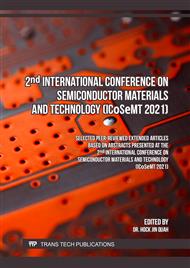[1]
M. Vasiliev, M. Nur-E-Alam, K. Alameh, Recent Developments in Solar Energy-Harvesting Technologies for Building Integration and Distributed Energy Generation, Energies, 12 (2019) 1080.
DOI: 10.3390/en12061080
Google Scholar
[2]
T. Zhang, M. Wang, H. Yang, A Review of the Energy Performance and Life-Cycle Assessment of Building-Integrated Photovoltaic (BIPV) Systems, Energies, 11 (2018).
DOI: 10.3390/en11113157
Google Scholar
[3]
T.E. Kuhn, C. Erban, M. Heinrich, J. Eisenlohr, F. Ensslen, D.H. Neuhaus, Review of technological design options for building integrated photovoltaics (BIPV), Energy and Buildings, 231 (2021) 110381.
DOI: 10.1016/j.enbuild.2020.110381
Google Scholar
[4]
J. Murray, D. Ma, J.N. Munday, Electrically Controllable Light Trapping for Self-Powered Switchable Solar Windows, ACS Photonics, 4 (2017) 1-7.
DOI: 10.1021/acsphotonics.6b00518
Google Scholar
[5]
L. Yuan, Z. Wang, R. Duan, P. Huang, K. Zhang, Q. Chen, N.K. Allam, Y. Zhou, B. Song, Y. Li, Semi-transparent perovskite solar cells: unveiling the trade-off between transparency and efficiency, Journal of Materials Chemistry A, 6 (2018) 19696-19702.
DOI: 10.1039/c8ta07318j
Google Scholar
[6]
T.M. Brenner, D.A. Egger, L. Kronik, G. Hodes, D. Cahen, Hybrid organic—inorganic perovskites: low-cost semiconductors with intriguing charge-transport properties, Nature Reviews Materials, 1 (2016) 15007.
DOI: 10.1038/natrevmats.2016.11
Google Scholar
[7]
R.K. Kothandaraman, Y. Jiang, T. Feurer, A.N. Tiwari, F. Fu, Near-Infrared-Transparent Perovskite Solar Cells and Perovskite-Based Tandem Photovoltaics, Small Methods, 4 (2020) 2000395.
DOI: 10.1002/smtd.202000395
Google Scholar
[8]
A.A.F. Husain, W.Z.W. Hasan, S. Shafie, M.N. Hamidon, S.S. Pandey, A review of transparent solar photovoltaic technologies, Renewable and Sustainable Energy Reviews, 94 (2018) 779-791.
DOI: 10.1016/j.rser.2018.06.031
Google Scholar
[9]
A. Extance, The reality behind solar power's next star material, Nature, 570 (2019).
DOI: 10.1038/d41586-019-01985-y
Google Scholar
[10]
M. Mujahid, C. Chen, J. Zhang, C. Li, Y. Duan, Recent advances in semitransparent perovskite solar cells, InfoMat, 3 (2021) 101-124.
DOI: 10.1002/inf2.12154
Google Scholar
[11]
J.C. Yu, J. Sun, N. Chandrasekaran, C.J. Dunn, A.S.R. Chesman, J.J. Jasieniak, Semi-transparent perovskite solar cells with a cross-linked hole transport layer, Nano Energy, 71 (2020) 104635.
DOI: 10.1016/j.nanoen.2020.104635
Google Scholar
[12]
A. Roy, A. Ghosh, S. Bhandari, S. Sundaram, T.K. Mallick, Perovskite Solar Cells for BIPV Application: A Review, Buildings, 10 (2020).
DOI: 10.3390/buildings10070129
Google Scholar
[13]
K.R. McIntosh, S.C. Baker-Finch, OPAL 2: Rapid optical simulation of silicon solar cells, Proceedings of the 38th IEEE Photovoltaic Specialists Conference, Austin, 2012.
DOI: 10.1109/pvsc.2012.6317616
Google Scholar
[14]
Information on https://www.pvlighthouse.com.au/.
Google Scholar
[15]
H. Mehdi, A. Mhamdi, R. Hannachi, A. Bouazizi, MAPbBr3 perovskite solar cells via a two-step deposition process, RSC Advances, 9 (2019) 12906-12912.
DOI: 10.1039/c9ra02036e
Google Scholar
[16]
Q. Wayesh, n.A.J. Yesmi, M.D. Gloria, M. Tashfiq, M.I. Hossain, S.N. Islam, Optical analysis in CH3NH3PbI3 and CH3NH3PbI2Cl based thin-film perovskite solar cell., American Journal of Energy Research, 3 (2015) 19-24.
Google Scholar



